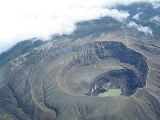
Santa Ana Volcano
Overview
Stratovolcano
A stratovolcano, also known as a composite volcano, is a tall, conical volcano built up by many layers of hardened lava, tephra, pumice, and volcanic ash. Unlike shield volcanoes, stratovolcanoes are characterized by a steep profile and periodic, explosive eruptions...
located in the Santa Ana department
Santa Ana Department
Santa Ana is a department of El Salvador in the northwest of the country. The capital is Santa Ana.- General information :It has 2,023 km² and a population of over 600,000. This department was created on February 8, 1855...
of El Salvador
El Salvador
El Salvador or simply Salvador is the smallest and the most densely populated country in Central America. The country's capital city and largest city is San Salvador; Santa Ana and San Miguel are also important cultural and commercial centers in the country and in all of Central America...
. At 2,381 metres above sea level, it is the highest volcano in the country. It is located immediately west of Coatepeque Caldera
Coatepeque Caldera
Coatepeque Caldera also known as Lago De Coatepeque is a volcanic caldera in El Salvador in Central America. The caldera was formed during a series of major rhyolitic explosive eruptions between about 72,000 and 57,000 years ago...
.
The summit of Santa Ana features four nested caldera
Caldera
A caldera is a cauldron-like volcanic feature usually formed by the collapse of land following a volcanic eruption, such as the one at Yellowstone National Park in the US. They are sometimes confused with volcanic craters...
s and volcanic crater
Volcanic crater
A volcanic crater is a circular depression in the ground caused by volcanic activity. It is typically a basin, circular in form within which occurs a vent from which magma erupts as gases, lava, and ejecta. A crater can be of large dimensions, and sometimes of great depth...
s, with the innermost containing a small crater lake
Crater lake
A crater lake is a lake that forms in a volcanic crater or caldera, such as a maar; less commonly and with lower association to the term a lake may form in an impact crater caused by a meteorite. Sometimes lakes which form inside calderas are called caldera lakes, but often this distinction is not...
. Collapse of the summit during the late Pleistocene
Pleistocene
The Pleistocene is the epoch from 2,588,000 to 11,700 years BP that spans the world's recent period of repeated glaciations. The name pleistocene is derived from the Greek and ....
(inferring from underlying soil samples, the upper age limit is no more than 57 000 years ago) produced a massive debris avalanche that reached the Pacific Ocean, forming the Acajutla Peninsula.
Unanswered Questions

